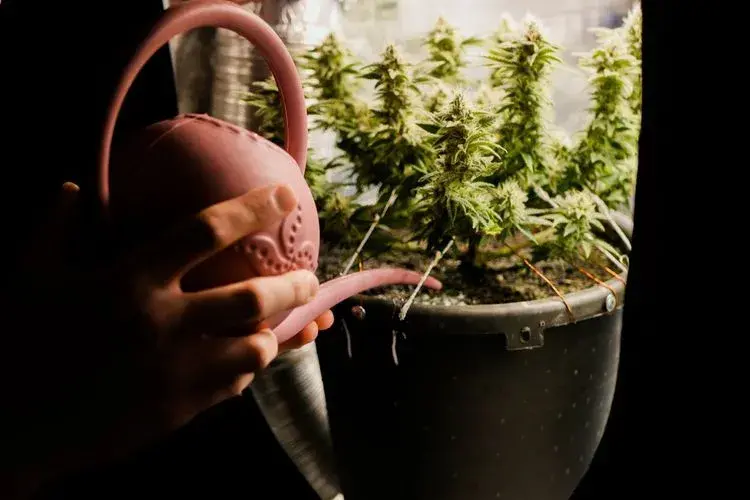Watering cannabis might seem like a straightforward task—just give the plants some water and they’re good to go, right? However, the reality is much more complex. Proper watering is crucial for the development of healthy cannabis plants capable of producing robust buds. In this guide, we’ll delve into the intricacies of watering cannabis, helping you master the art of hydration to ensure your plants thrive, especially in varying Canadian climates.
The Art of Watering Cannabis

When it comes to cannabis cultivation, water is more than just a necessity; it’s a critical component of plant health and productivity. Cannabis plants are composed of almost 90% water, which plays several vital roles in their life cycle. Water is indispensable for maintaining cell structure, facilitating photosynthesis, transporting nutrients, and even for the germination of seeds. A cannabis plant’s need for water begins from the very first stage of its life and continues until harvest.
Understanding the importance of water, it’s essential to adopt precise watering techniques to avoid common pitfalls. Overwatering, for instance, can lead to root rot and nutrient uptake issues, while under-watering can stress plants, potentially stunting growth or leading to poor bud development.
Why Cannabis Needs Water
- Structural Integrity: Water keeps the plant cells turgid, ensuring the plant remains upright and strong.
- Photosynthesis: Without water, plants can’t synthesize food, which is vital for their growth and energy storage.
- Seed Germination: Water activates the germination process, without which seeds remain dormant.
- Nutrient Transport: Water dissolves nutrients, making them available for root absorption.
- Temperature Regulation: Through transpiration, plants use water to cool themselves during hot conditions.
- Supporting Soil Life: Water is crucial for the survival of beneficial microbes in the soil, which in turn help in nutrient breakdown and absorption.
Learning When and How to Water Cannabis Plants
Proper watering is about more than just the amount of water you give your plants; it’s also about the timing and method of watering. For outdoor cannabis grows in Canada, the natural climate plays a significant role. Factors like rainfall and temperature must be considered to adjust watering schedules. In contrast, indoor growers have complete control over their watering regimes but must be diligent to avoid overwatering or under-watering.
- Outdoor Growing: Always account for natural rainfall by using a rain gauge. This helps you adjust your watering schedule based on how much water nature is already providing. During dry spells, increased watering is necessary, while rainy periods might reduce the need for manual watering.
- Indoor Growing: Indoor environments allow for precise control over watering. It’s advisable to let the soil dry out slightly between waterings to prevent root rot. Many growers use systems that automate the watering process, ensuring plants receive the right amount of water at the right time.
Choosing the Right Watering Techniques
Watering should begin near the stem and gradually extend outward to encourage roots to grow towards the water source. This technique helps develop a robust root system, essential for healthy plant growth. For young plants, gentle watering methods such as using a spray nozzle are recommended to avoid disturbing the delicate roots and shoots.
Understanding the water needs of cannabis is crucial for any grower. Whether you’re cultivating a personal grow in Canada or managing a larger operation, mastering the art of watering will significantly impact your success. In the following sections, we will explore the best water sources for cannabis, discuss the importance of water quality, and provide detailed guidelines on how much and how often to water your plants to maximize their health and yield.
Water Quality Matters
The quality of water used in cannabis cultivation can significantly affect plant health and growth. For indoor growers, especially in regions like Canada where water hardness varies, it’s vital to understand the impact of tap water on your plants. Hard water, which is high in dissolved minerals like calcium and magnesium, can lead to nutrient imbalances and may even harm your plants or the irrigation system over time.
Many seasoned growers prefer using filtered or reverse osmosis (RO) water, which removes most of the impurities and minerals, providing a clean slate for precise nutrient management. This approach is particularly beneficial in areas with hard water. However, rainwater is an excellent alternative for outdoor growers, as it is naturally soft and free of chlorine and other municipal water additives. Collecting and storing rainwater not only reduces water costs but also aligns with organic growing practices by providing a more natural water source for your plants.
The Right pH for Cannabis
The pH level of the water used for watering cannabis plants is crucial for optimal growth. Cannabis prefers a slightly acidic environment with a pH range of about 6.0 to 7.0. Water that is too acidic or too alkaline can hinder the plant’s ability to absorb nutrients effectively, potentially leading to deficiencies or toxicities. Regularly checking and adjusting the pH of your water ensures that nutrients are available to your plants, which is essential for healthy growth and robust yields.
Indoor growers must be particularly vigilant about pH levels, as controlled environments can lead to quicker shifts in pH balance. Simple pH meters or testing kits can be used to monitor and adjust your water’s pH as needed, ensuring that your cannabis plants are always in the optimal growing environment.
Adding Nutrients: When and How Much?
Whether to add nutrients to your watering regimen depends largely on the growth medium and the stage of plant development. Cannabis requires different nutrient mixes during the vegetative and flowering stages. Inert media like rock wool or clay pellets will require a complete nutrient solution, while richer organic soils may only need supplemental feeding.
Nutrient overfeeding is a common issue that can lead to ‘nutrient burn,’ characterized by the tips of the leaves turning brown and crispy. Conversely, underfeeding can starve your plants, leading to stunted growth and poor development. Using a balanced nutrient solution and following manufacturer recommendations can help avoid these issues. However, observing your plants for signs of distress is crucial and can guide you in adjusting your nutrient concentrations appropriately.
Read- Germinating Cannabis Seeds: Indoor vs. Outdoor Techniques
Hydration Through the Life Cycle
Water requirements for cannabis vary significantly throughout its life cycle. Seedlings need minimal water compared to fully mature plants. Overwatering young plants is a common mistake that can lead to damping off and other fungal diseases. As plants grow, their water needs increase. Mature plants, especially during the flowering stage, might require substantial amounts of water to support their rapid growth and bud formation.
Understanding the specific needs of your cannabis plants at each stage of their development is crucial for maintaining optimal hydration levels. Regularly assessing the moisture content of your growing medium, whether by touch or using moisture meters, can help you determine the ideal watering schedule.
In the next section, we’ll cover practical techniques for watering your cannabis effectively, including advanced methods like drip irrigation and ebb-and-flow systems, ensuring that you have all the tools necessary to manage water efficiently in both indoor and outdoor settings. Stay tuned to learn more about these innovative watering practices that can take your cannabis cultivation to the next level.
Implementing Drip Irrigation
Drip irrigation is a highly efficient watering method particularly suited to both indoor and outdoor cannabis cultivation. This system delivers water directly to the base of each plant through a network of tubing and emitters. This precise delivery ensures that water is used optimally, reducing waste and minimizing the risk of overwatering. For cannabis growers in Canada, where water conservation may be essential during dry months, drip irrigation offers a sustainable solution that can significantly improve water use efficiency.
The advantages of drip irrigation include its ability to maintain an ideal moisture level around the roots, encouraging healthy root development and better nutrient uptake. Additionally, because water is delivered slowly and directly to the soil, there is minimal evaporation, which is particularly beneficial during the hot summer months.
Ebb and Flow Systems
Another sophisticated watering technique used primarily in indoor grows is the ebb and flow system, also known as flood and drain. This method involves periodically flooding the grow tray with nutrient-rich water, which then slowly drains back into a reservoir. This action not only hydrates the roots but also oxygenates them, promoting vigorous growth.
Ebb and flow systems are particularly effective for cannabis because they allow for complete control over the watering cycle and nutrient application. This control can lead to faster growth and higher yields, especially when combined with a controlled environment that optimizes temperature and humidity levels.
Watering Based on Environmental Conditions
Understanding and adapting to environmental conditions is crucial for effective cannabis watering, especially in regions like Canada with diverse climates. Outdoor growers need to consider local weather patterns, adjusting their watering schedule based on rainfall, temperature, and humidity. For instance, during prolonged dry spells, increasing the frequency and volume of watering will help maintain the health of cannabis plants.
Indoor growers, while less affected by external weather, still need to monitor environmental conditions closely. Factors such as air conditioning, heating, and ventilation can all affect indoor humidity levels and thus the rate of soil drying. Advanced growers often use environmental control systems that automatically adjust conditions to maintain optimal growth settings, including soil moisture levels.
Moisture Monitoring Techniques
To avoid the pitfalls of both over and under-watering, growers can employ various moisture monitoring techniques. Using soil moisture meters is a reliable method for checking the water content of your grow medium directly. These devices provide a quick and accurate reading, which is invaluable for ensuring consistent moisture levels throughout the grow area.
Another simple yet effective method is the traditional finger test. By inserting a finger up to the second knuckle into the soil, growers can feel whether the grow medium is dry or moist. This technique, while rudimentary, gives an immediate sense of whether additional watering is needed.
Maintaining Water Quality
Finally, maintaining water quality throughout the growing cycle is essential. This involves regularly cleaning reservoirs, filters, and irrigation systems to prevent the buildup of algae, bacteria, and mineral deposits. Such buildups can clog watering systems and potentially introduce harmful pathogens to the cannabis plants.
For those using tap water, it might be necessary to adjust for chlorine or other chemicals typically found in municipal water supplies. Letting tap water stand for 24 to 48 hours before use can allow chlorine to dissipate naturally, which is a simple yet effective way to improve water quality for your plants.
By mastering these advanced watering techniques and understanding the unique needs of cannabis in various growth stages and conditions, growers can optimize their cultivation practices. This not only maximizes plant health and yield but also ensures efficient use of resources, a critical consideration in sustainable agricultural practices. Whether growing a small personal batch or managing a larger commercial operation, these strategies form the cornerstone of successful cannabis cultivation.
Conclusion
Successful cannabis cultivation hinges significantly on mastering the art of watering. By understanding the specific water requirements throughout the different stages of a cannabis plant’s lifecycle and adjusting for environmental conditions, growers can ensure optimal growth and maximize yields. Whether managing a small indoor setup or a large outdoor farm, the principles of careful water management apply universally.
Implementing advanced techniques such as drip irrigation or ebb and flow systems can enhance water usage efficiency, contributing to sustainable growing practices. Additionally, monitoring and maintaining water quality, along with precise pH management, are crucial for preventing nutrient imbalances and promoting robust plant health.
Ultimately, each grower’s approach will vary depending on their specific circumstances, including local climate conditions in regions like Canada, the type of grow medium used, and the particular strains of cannabis cultivated. By embracing both the science and art of watering cannabis, growers can not only improve their cultivation skills but also enjoy the rewarding process of nurturing their plants to produce the best possible harvest.
